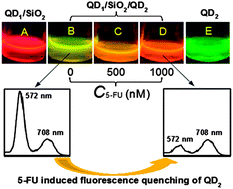Compared to single photoluminescence (PL) intensity-based sensors, dual-emitting-based ratiometric PL sensors are more preferable because the influence from PL fluctuation in the reagents and background PL can be reduced to a minimum. However, so far no report has been directed to the ratiometric PL detection of 5-fluorouracil (5-FU). In this study, for the first time, high-quality quantum dots (QD1)/mesoporous silica (SiO2)/quantum dots (QD2) core/shell/shell hybrid microspheres (QD1/SiO2/QD2) were prepared by self-assembly, and further developed toward a ratiometric PL sensor of 5-FU. The addition of 5-FU induced regular PL quenching of QD2, but hardly influenced on the PL of QD1 in the microspheres. Based on the linear relationship (R = −0.9994) between the ratiometric PL intensity (IQD2/IQD1) and the molar concentration of 5-FU (0–1 μM), a ratiometric PL sensor for 5-FU was achieved and displays a low limit of detection (20 nM). Experimental results testified that this sensor for the detection of 5-FU in human serum samples was highly sensitive and selective over other inorganic ions and biological molecules. Compared with conventional analysis techniques and other spectrofluorimetric methods reported previously, this proposed ratiometric PL sensor could be a good candidate for the highly efficient detection of 5-FU.

You have access to this article
 Please wait while we load your content...
Something went wrong. Try again?
Please wait while we load your content...
Something went wrong. Try again?


 Please wait while we load your content...
Please wait while we load your content...